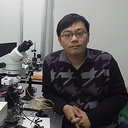Angelica Sinensis polysaccharides stimulated UDP-sugar synthase genes through promoting gene expression of IGF-1 and IGF1R in chondrocytes: promoting anti-osteoarthritic activity.
Açar sözlər
Mücərrəd
BACKGROUND
Osteoarthritis (OA) is a chronic joints disease characterized by progressive degeneration of articular cartilage due to the loss of cartilage matrix. Previously, we found, for the first time, that an acidic glycan from Angelica Sinensis Polysaccharides (APSs), namely the APS-3c, could protect rat cartilage from OA due to promoting glycosaminoglycan (GAG) synthesis in chondrocytes. In the present work, we tried to further the understanding of ASP-3c's anti-OA activity.
RESULTS
Human primary chondrocytes were treated with APS-3c or/and recombinant human interleukin 1β (IL-1β). It turned out that APS-3c promoted synthesis of UDP-xylose and GAG, as well as the gene expression of UDP-sugar synthases (USSs), insulin like growth factor 1 (IGF1) and IGF1 receptor (IGF1R), and attenuated the degenerative phenotypes, suppressed biosynthesis of UDP-sugars and GAG, and inhibited the gene expression of USSs, IGF1 and IGF1R induced by IL-1β. Then, we induced a rat OA model with papain, and found that APS-3c also stimulated GAG synthesis and gene expression of USSs, IGF1 and IGF1R in vivo. Additionally, recombinant human IGF1 and IGF1R inhibitor NP-AEW541 were applied to figure out the correlation between stimulated gene expression of USSs, IGF1 and IGF1R induced by APS-3c. It tuned out that the promoted GAG synthesis and USSs gene expression induced by APS-3c was mediated by the stimulated IGF1 and IGF1R gene expression, but not through directly activation of IGF1R signaling pathway.
CONCLUSIONS
We demonstrated for the first time that APS-3c presented anti-OA activity through stimulating IGF-1 and IGF1R gene expression, but not directly activating the IGF1R signaling pathway, which consequently promoted UDP-sugars and GAG synthesis due to up-regulating gene expression of USSs. Our findings presented a better understanding of APS-3c's anti-OA activity and suggested that APS-3c could potentially be a novel therapeutic agent for OA.




